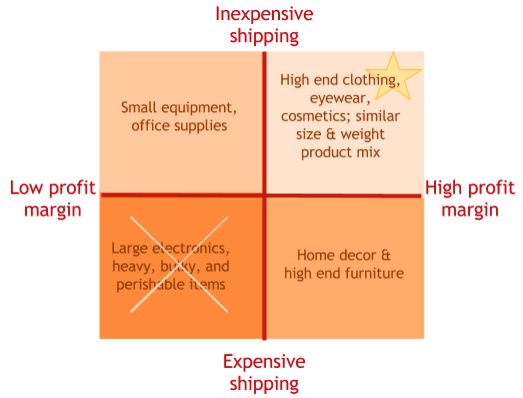Shipping is at the core of eCommerce business. It is fundamental, but like a lot of fundamental things, it doesn’t get a lot of attention until it stops working.
Online retailers have felt consumer pressure (some real and some perceived) to switch to free or single flat rate shipping models to remain competitive. These may seem like straightforward and inexpensive shipping models for customers, but if this type of shipping does not fit your business, they can have a painful and dramatic effect on your bottom line as your business grows.
Having a solid shipping strategy is crucial to the success of your business, and it must be carefully built with your business and customers in mind. Your products, warehouse locations, and target customers will determine which approach is right for you. Don’t feel obligated to adopt the model your competitors use, even if it seems they all use the same one. What works for them may not work for you—and in reality, it may not really work for them either. It’s easy to feel trapped by the standard big-box retailer models, but you have other options that are fair to both your customers and your budget.
Strategy is about making choices, trade-offs; it’s about deliberately choosing to be different. – Michael E. Porter, Professor at Harvard Business School
Identify The Problem
The first step to recovery is being able to identify that something isn’t working. The wrong shipping strategy only gets worse as your business scales, and unfortunately, it can take a major profit loss to even see that you have a problem.
We recently worked with a client who had adopted a low-cost flat rate shipping model that had become standard in their industry. (Think of those retailers who offer shipping fees at just a few bucks per order, regardless of product size or weight. That’s low-cost flat rate shipping.) With so many competing businesses using the same model, it’s natural to assume it must be the best choice. But without additional information, who’s to say it’s actually successful? Everyone could be losing their shirts while assuming the strategy is working for their competition.
Build time into your schedule to stop and take a critical look at your own shipping strategy. Look at the hard numbers, and determine if your model is working for your bottom line or against it. Our client realized their shipping method wasn’t sustainable, so as their partner, we stepped in to work with them and find a solution together.
Back To The Drawing Board
Once you’ve determined that a new strategy is needed, the first step should be doing some research.
The essence of strategy is choosing what not to do. – Michael E. Porter
Our research began with identifying what types of retailers can successfully offer free or low flat rate shipping methods. What we found is that offering those shipping models only makes sense if you can either factor the additional expense into your product cost or build your marketing and promotion budget to absorb the loss in shipping fees. If you can’t maintain a profit margin while doing either of the above, you can’t afford free or low-cost flat rate shipping.
Apply The Research
We began analyzing viable shipping methods by first identifying the product types our client sells. Their main products are relatively heavy items with low profit margins. We quickly ruled out free or low flat rate shipping as feasible options.
Determine where the majority of your product types fall within this scale. Do the math:
Cost of product +
Packaging +
Shipping costs +
Fees +
Profit Margin
TOTAL SALE PRICE
Consider how you’re charged for shipping. Does your shipping company round package weights up? Have you negotiated your rates with your shipping company lately? What rates do they offer your competitors?
Define Your Goals
In our case, the goals were simple: eliminate shipping losses, remain true and fair to loyal customers, and keep the shipping model simple. We ultimately decided that tiered shipping using flat rate weight-based shipping tiers was the most economical and simple solution. So for example, every package up to 2 pounds would have one shipping fee; every package between 2.1 to 4 pounds would have another, slightly more expensive shipping fee, and so on. We took a close look at historical sales and shipping expense data and came up with weight-based tiers that made sense to us. Then we checked in with the customers.
Figure out what your main goals should be, based on your priorities, growth plans, and business philosophy. Explore options that align with these goals, do the research about those options, look at your own data, and determine which seems the most viable.
Get Customer Feedback
The most important voice is that of your customer. Research and speculation are valuable, but getting real feedback from real customers is invaluable.
For our client, we ran a survey to find out what their customers thought about various shipping options, and to see how shipping affects their buying decisions. Though we all like to assume we know our customers, a survey is a great tool to test those assumptions. Your customer might surprise you. In this case, the feedback from our client’s customers surprised us all, and it helped us finalize our strategy.
Roll It Out
Most eCommerce retailers have clear seasonal peaks. It’s best to make changes during the lulls, so you can find out if your new strategy will be successful without risking a major impact on your annual goals. We chose a relatively slow season to introduce our changes and monitor the results. We also made sure our client will have plenty of time to make any adjustments needed before their next high traffic season.
Think about your own sales cycles. Determine an ideal time to roll out your changes, a safe distance away from the most critical periods on your company calendar.
Follow Up
However beautiful the strategy, you should occasionally look at the results. – Winston Churchill
Any time you make a major change in your business strategy, it’s vital to create a feedback loop. Since this change was such an important one for our client, and since it carried the potential for a large financial impact, we created a short feedback loop. We decided our check-ins would take place after one week, one month, and at the end of the quarter, and they’d involve a hard look at the books to compare the change we anticipated to actual results. Our strategy has worked beautifully thus far, but we’ll continue checking in be sure it continues.
Never rest on your laurels. Check your numbers. Make sure the research, goals, solution, and feedback all amount to the payoff your business needs, and then continue evaluating it periodically, perhaps as a part of your annual review.
Wrapping Up
Business success isn’t determined by always getting it right the first time around. The ability to stay adaptable and open to change is one of the hardest, but most important skills to harness as a business leader. The eCommerce landscape will continue to evolve and as it does, strategies that once worked may no longer be viable or wise. During those times of change, trial and error can be your only option. But trial and error can also show you new, creative ways to solve problems and stay ahead in your market. Shipping is one area where regular, objective evaluation can really pay off—for you, your business, and your customers.
Have you evaluated your shipping method lately? How does your shipping model interact with your long-term goals and overall business philosophies? Have any questions about our client project? Give us your feedback in the comments below. And as always, if your business could benefit from an ally with exposure and experience in the eCommerce market, contact us to see how a partnership with Gauge could work for you.





